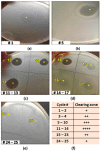Antimicrobial Protein Candidates from the Thermophilic Geobacillus sp. Strain ZGt-1: Production, Proteomics, and Bioinformatics Analysis
- PMID: 27548162
- PMCID: PMC5000758
- DOI: 10.3390/ijms17081363
Antimicrobial Protein Candidates from the Thermophilic Geobacillus sp. Strain ZGt-1: Production, Proteomics, and Bioinformatics Analysis
Abstract
A thermophilic bacterial strain, Geobacillus sp. ZGt-1, isolated from Zara hot spring in Jordan, was capable of inhibiting the growth of the thermophilic G. stearothermophilus and the mesophilic Bacillus subtilis and Salmonella typhimurium on a solid cultivation medium. Antibacterial activity was not observed when ZGt-1 was cultivated in a liquid medium; however, immobilization of the cells in agar beads that were subjected to sequential batch cultivation in the liquid medium at 60 °C showed increasing antibacterial activity up to 14 cycles. The antibacterial activity was lost on protease treatment of the culture supernatant. Concentration of the protein fraction by ammonium sulphate precipitation followed by denaturing polyacrylamide gel electrophoresis separation and analysis of the gel for antibacterial activity against G. stearothermophilus showed a distinct inhibition zone in 15-20 kDa range, suggesting that the active molecule(s) are resistant to denaturation by SDS. Mass spectrometric analysis of the protein bands around the active region resulted in identification of 22 proteins with molecular weight in the range of interest, three of which were new and are here proposed as potential antimicrobial protein candidates by in silico analysis of their amino acid sequences. Mass spectrometric analysis also indicated the presence of partial sequences of antimicrobial enzymes, amidase, and dd-carboxypeptidase.
Keywords: Geobacillus; SDS-resistant proteins; antimicrobial proteins; cell-recycling; food spoilage bacteria; immobilization; thermophile.
Figures




Similar articles
-
Genome Sequence of Geobacillus sp. Strain ZGt-1, an Antibacterial Peptide-Producing Bacterium from Hot Springs in Jordan.Genome Announc. 2015 Jul 23;3(4):e00799-15. doi: 10.1128/genomeA.00799-15. Genome Announc. 2015. PMID: 26205859 Free PMC article.
-
Purification studies on a thermo-active amidase of Geobacillus pallidus BTP-5x MTCC 9225 isolated from thermal springs of Tatapani (Himachal Pradesh).Appl Biochem Biotechnol. 2013 Jan;169(1):1-14. doi: 10.1007/s12010-012-9945-8. Epub 2012 Oct 25. Appl Biochem Biotechnol. 2013. PMID: 23096998
-
Thermal Proteome Profiling and Meltome Analysis of a Thermophilic Bacterial Strain, Geobacillus thermoleovorans ARTRW1: Toward Industrial Applications.OMICS. 2020 Dec;24(12):756-765. doi: 10.1089/omi.2020.0115. Epub 2020 Oct 20. OMICS. 2020. PMID: 33085568
-
Habitat, applications and genomics of the aerobic, thermophilic genus Geobacillus.Biochem Soc Trans. 2004 Apr;32(Pt 2):214-7. doi: 10.1042/bst0320214. Biochem Soc Trans. 2004. PMID: 15046574 Review.
-
The genus Geobacillus and their biotechnological potential.Adv Appl Microbiol. 2015;92:1-48. doi: 10.1016/bs.aambs.2015.03.001. Epub 2015 May 5. Adv Appl Microbiol. 2015. PMID: 26003932 Review.
Cited by
-
Omics for Bioprospecting and Drug Discovery from Bacteria and Microalgae.Antibiotics (Basel). 2020 May 4;9(5):229. doi: 10.3390/antibiotics9050229. Antibiotics (Basel). 2020. PMID: 32375367 Free PMC article. Review.
-
Isolation of a broad spectrum antimicrobial producing thermophilic Bacillus and characterization of its antimicrobial protein.Arch Microbiol. 2021 Jul;203(5):2059-2073. doi: 10.1007/s00203-020-02162-w. Epub 2021 Feb 11. Arch Microbiol. 2021. PMID: 33575852
-
Isolation of Thermophilic Bacteria Geobacillus subterraneus From Mount Tangkuban Perahu and the Novelty as a Candidate for Streptococcus mutans Anti-Biofilm.Int J Dent. 2024 Nov 25;2024:4285984. doi: 10.1155/ijod/4285984. eCollection 2024. Int J Dent. 2024. PMID: 39629160 Free PMC article.
-
Expression of BSN314 lysozyme genes in Escherichia coli BL21: a study to demonstrate microbicidal and disintegarting potential of the cloned lysozyme.Braz J Microbiol. 2024 Mar;55(1):215-233. doi: 10.1007/s42770-023-01219-4. Epub 2023 Dec 26. Braz J Microbiol. 2024. PMID: 38146050 Free PMC article.
-
Taxonomic Diversity and Antimicrobial Potential of Thermophilic Bacteria from Two Extreme Algerian Hot Springs.Microorganisms. 2025 Jun 19;13(6):1425. doi: 10.3390/microorganisms13061425. Microorganisms. 2025. PMID: 40572313 Free PMC article.
References
-
- Ravot G., Masson J.M., Lefevre F. 34 Applications of extremophiles: The industrial screening of extremophiles for valuable biomolecules. Method Microbiol. 2006;35:785–813.
-
- Esikova T.Z., Temirov Y.V., Sokolov S.L., Alakhov Y.B. Secondary antimicrobial metabolites produced by thermophilic Bacillus spp. strains VK2 and VK21. Appl. Biochem. Microbiol. 2002;38:226–231. - PubMed
MeSH terms
Substances
LinkOut - more resources
Full Text Sources
Other Literature Sources

